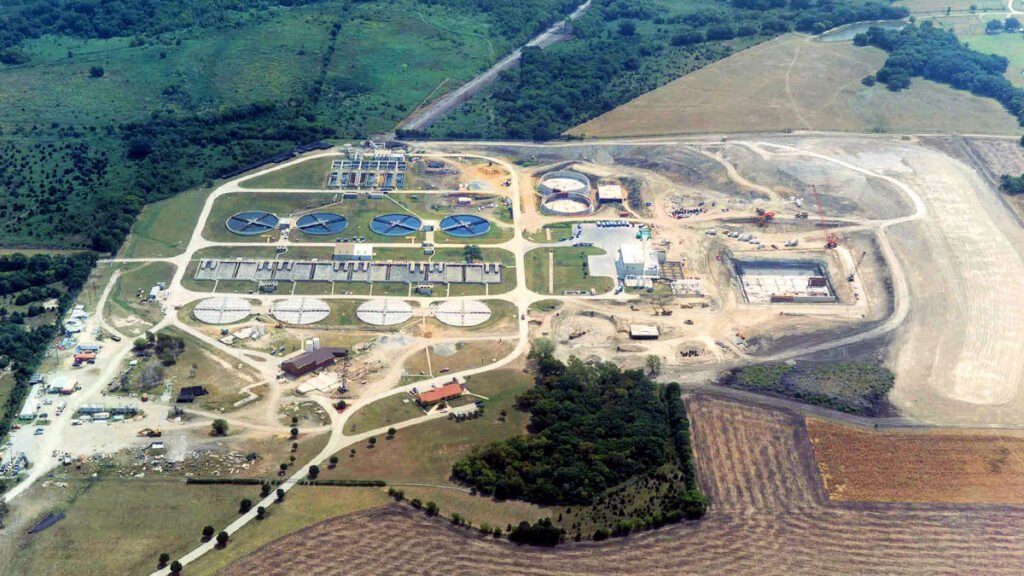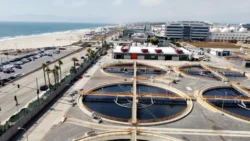Wilson Creek Regional Wastewater Treatment Plant

Wilson Creek Regional Wastewater Treatment Plant: A Cornerstone of Environmental Stewardship
Introduction
The Wilson Creek Regional Wastewater Treatment Plant (WCRWTP) stands as a monumental contributor to maintaining environmental and public health standards in its service area. Located in McKinney, Texas, this facility is crucial for managing and treating wastewater from numerous communities, ensuring that the treated water re-entering the environment meets stringent quality standards.
Population Served
Serving a rapidly growing population, the WCRWTP caters to approximately 1.5 million residents. This number is expected to rise as more people move into the Dallas-Fort Worth metroplex region. The plant’s service area encompasses several municipalities, including McKinney, Frisco, Allen, and neighboring communities. Its importance is amplified by the population boom in North Texas, reinforcing the need for robust wastewater treatment infrastructure to support public health and environmental sustainability.
Wastewater Volume and Treatment Capacity
Wilson Creek Regional Wastewater Treatment Plant currently manages an average daily wastewater volume of about 64 million gallons per day (MGD). However, this number can fluctuate based on various factors, such as weather conditions and seasonal variations in water usage. The facility is designed to handle a peak flow capacity of 80 MGD, with room for future expansions that would raise this capacity even further.
The comprehensive treatment process is a multi-staged operation that includes preliminary screening, primary sedimentation, biological treatment, secondary clarification, and advanced tertiary treatments. Each stage is meticulously designed to remove contaminants, ensuring that the discharged water is free from harmful substances.
Recent Local News
In recent years, the WCRWTP has attracted attention for various upgrades and key projects aimed at enhancing its operational efficiency and environmental stewardship. For instance, a notable expansion project was initiated in 2020, aimed at increasing the plant’s treatment capacity to 100 MGD by 2025. This project involved the construction of additional aeration basins, secondary clarifiers, and the implementation of cutting-edge membrane bioreactor (MBR) technology.
In 2022, the plant achieved a milestone by reducing its energy consumption by 15%, thanks to the incorporation of energy-efficient equipment and optimized operational protocols. This not only lowered operational costs but also significantly reduced the plant’s carbon footprint, aligning with environmental sustainability goals.
On the community level, the plant hosted an open house in early 2023 to educate residents about its operations and the vital role it plays in regional wastewater management. The event featured guided tours, interactive exhibits, and presentations from environmental scientists, highlighting the plant’s commitment to transparency and community engagement.
Key Projects
Several key projects at WCRWTP have been instrumental in enhancing its capacity and efficiency. Here are a few notable ones:
-
- Capacity Expansion Project: As previously mentioned, this multi-phase project aims to increase the treatment capacity to meet future demands. It includes infrastructure upgrades like the expansion of aeration basins and the integration of MBR technology, which offers higher efficiency and reliability in wastewater treatment.
-
- Effluent water Reuse Initiative: To promote water conservation, the plant has partnered with local municipalities to develop an effluent water reuse program. Treated wastewater is repurposed for non-potable applications such as irrigation for parks and golf courses, industrial cooling processes, and even as a supply for artificial lakes. This initiative helps conserve potable water resources and supports sustainable water management practices.
-
- Biosolids Management Program: This program focuses on the beneficial reuse of biosolids generated during the treatment process. Through advanced anaerobic digestion and composting methods, the biosolids are converted into nutrient-rich compost, which is then distributed to local farmers and landscapers. This not only diverts waste from landfills but also enriches soil health in the community.
-
- Energy Optimization Project: As part of its commitment to reducing its environmental footprint, the WCRWTP has implemented several energy-efficient upgrades. These include the installation of high-efficiency blowers, the use of variable frequency drives (VFDs) to optimize motor performance, and the incorporation of real-time energy monitoring systems. These measures have significantly reduced the plant’s energy consumption and operational costs.
Community Engagement
The WCRWTP places a strong emphasis on community engagement, fostering a positive relationship with the residents it serves. Here are some of the ways the plant engages with the community:
-
- Educational Outreach: The plant regularly conducts educational outreach programs for local schools and community groups. These programs aim to raise awareness about the importance of wastewater treatment and environmental conservation. Plant staff often visit schools to give presentations and conduct hands-on activities, helping to inspire the next generation of environmental stewards.
-
- Public Tours and Open Houses: The WCRWTP frequently opens its doors to the public, offering guided tours and open house events. These tours provide residents with an inside look at the plant’s operations and the technology used to treat wastewater. Open house events often feature interactive exhibits, educational displays, and opportunities to speak with plant staff and environmental scientists.
-
- Stakeholder Engagement: The plant actively engages with local stakeholders, including municipal leaders, environmental organizations, and residents. Regular stakeholder meetings are held to discuss ongoing projects, address community concerns, and gather feedback. This collaborative approach ensures that the plant’s operations align with the needs and priorities of the community.
-
- Community Advisory Committee: The WCRWTP has established a Community Advisory Committee (CAC) composed of local residents, business owners, and environmental advocates. The CAC serves as a liaison between the plant and the community, providing valuable input on plant operations, proposed projects, and future plans. This committee plays a crucial role in fostering transparency and community trust.
-
- Volunteer Programs: The plant offers volunteer programs that encourage community members to get involved in environmental stewardship activities. Volunteers can participate in activities such as tree planting, creek clean-ups, and educational workshops. These programs help build a sense of ownership and pride among residents, fostering a culture of environmental responsibility.
Conclusion
The Wilson Creek Regional Wastewater Treatment Plant is a shining example of how modern technology and community engagement can come together to address the challenges of wastewater management. Serving over a million residents in a rapidly growing region, the plant’s commitment to capacity expansion, energy optimization, and environmental sustainability ensures that it will continue to play a vital role in maintaining public health and environmental quality.
Through its key projects and community engagement initiatives, the WCRWTP not only meets the current needs of its service area but also prepares for future growth and environmental challenges. As the region continues to develop, the plant’s ongoing efforts to innovate and collaborate with the community will undoubtedly contribute to a more sustainable and resilient future.


